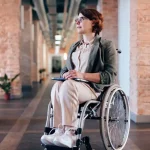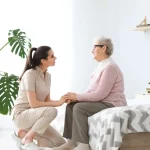My mother had thin skin on her arms. One day she tripped and almost fell while I was standing next to her. I reached out and grasped her arm to steady her while she recovered her balance.
She was fine,… accident avoided. Later that day, I was shocked to see a reddish-blue handprint on her arm.
My mother was diagnosed with lung cancer. She was 74 years old and had thin skin on her arms.
The splotches on her arms resulted from several contributing factors: her age, the medications she was taking, and the general decline in her overall health, which seemed to worsen the bruising. My family and I moved into her home to be caregivers.
Her skin appeared to be very thin and fragile. Any bump or scrape could cause a skin tear. Bandages and medical tape could further tear the skin during removal. Something needed to be done.
“As people grow older, their skin tends to become more fragile, and they lose the nice layer of fat that lies right under the skin, which used to protect them from bumps and bruises.
Regarding your mother’s skin issue, it is common for this bruising to happen as people age. The “splotches” you speak of can be worse if someone is on a blood thinner (like Aspirin, Coumadin. or Plavix), commonly used to prevent strokes and heart attacks in older folks.
Another medication that can do this is Prednisone, which can thin the skin and cause bruising. Check with your health care provider if taking any of these medications, especially if the bruising gets severe.”
Jennifer Serafin, NP – a registered nurse and geriatric nurse practitioner at the Jewish Homes for the Aged in San Francisco
There were several things we did to address this problem of thin skin. Though we could not completely resolve the issue, we were able to take steps to manage her care and environment in a way that lessened the opportunity for injury.
What You Can Do
- Talk with your doctor. Some medications may contribute to your thin skin, which could be substituted or are no longer necessary.
Some “hard-to-heal” wounds require a doctor’s attention. In our case, our doctor said some medications were contributors, but they were necessary and needed to be continued. - Cover the arms with socks. We took socks and cut the toes out, and slipped them over her arms. Not too tight to pinch or be uncomfortable, but not too loose to “sag” and be a nuisance.
White tube socks worked well for my mother. I cut the toes out but left a small strip between the thumb and forefinger.
They helped to protect her arms from the hands up to her elbows. They are washable and inexpensive. I like that. - Paper tape bandages. This may not work for everyone, so carefully test in a small area before regular use. We found that “Paper Tape” would be more easily released than other types of tape.
When I needed to treat a wound, I would use an as little amount of tape as necessary. I even used scissors to shape the tape before applying it. Don’t be in a hurry.
I would study the wound and its location to determine the best layout and amount of tape needed. The idea is to adequately bandage the wound in a way so as to remain in place and use the smallest amount of tape possible.
Using less tape means fewer chances of causing additional tears of the thin skin. - Remove bandages with care. When it was time for me to remove a bandage, I used a “light” touch and worked slowly and carefully. If the tape had a strong grip on the skin, I stopped.
If I dampened the tape with a damp washcloth and let it soak for a few minutes, it would usually release. If that didn’t work, I tried a small amount of mineral oil applied to the tape.
If the tape you’re using is a problem, then discontinue use and get a different kind. Look for paper type, maybe one listed as “sensitive skin” or “easy release.” - Use a Gait Belt. Our Physical Therapist used a gait belt when working with her. I had never seen one before, but its usefulness was apparent. The thing is, my mother didn’t come with any handles.
Every time I wanted to help her out of bed or into a chair, I instinctively reached for her arms. But that was not good for her thin skin. That’s where the gait belt is helpful.
A caregiver has something to grab for support assistance. But gaits belts are not for everyone. People who’ve had abdominal surgeries or back issues are at risk of injury from a gait belt.
To know if a gait belt is right for you, talk to your doctor first.
Everyone is different, so what helped our thin skin problem may not help you. Still, trying these tips may help you improve your situation. Review them with your doctor to be sure.

